Women Against KXL Pipeline
Mississippi River Basin
|
NEW ESRI StoryMaps: What's On Our Shelves & NWNL Song Library & No Water No Life ESRI |
Mississippi River Basin
Jeanne Crumly
Former Teacher
Sharyn Troester
From Chicago
Jennifer Troester
Teacher of gifted students
Alison M. Jones
NWNL Director and Photographer
Due to chance at an O’Neill restaurant, I met the Troesters, one of 40 Nebraska families opposing Trans-Canada efforts to run its Keystone XL oil pipeline across their farms. My pre-expedition efforts to contact those families were unsuccessful. So, I left NYC just hoping I might meet them while documenting the proposed KXL route across Nebraska farms and its 40 tributaries flowing eastward to the Missouri River. My concern, backed up by the Troesters was that any oil leaks would pollute Nebraska’s crops, its waters and the Ogallala Aquifer.
Thankfully, Jennifer Troester and her mother Sharyn gathered their friends for an amazing 3-hour chat on KXL concerns, easements, and a reliance on principles and a good life. The meeting clearly underlined their determination to protect their lifestyle.
Final Outcome: The result of this pipeline protest is documented NRDC’s Article on “What is the Keystone XL Pipeline.” The KXL veto was made by President Biden on Jan 20, 2021.
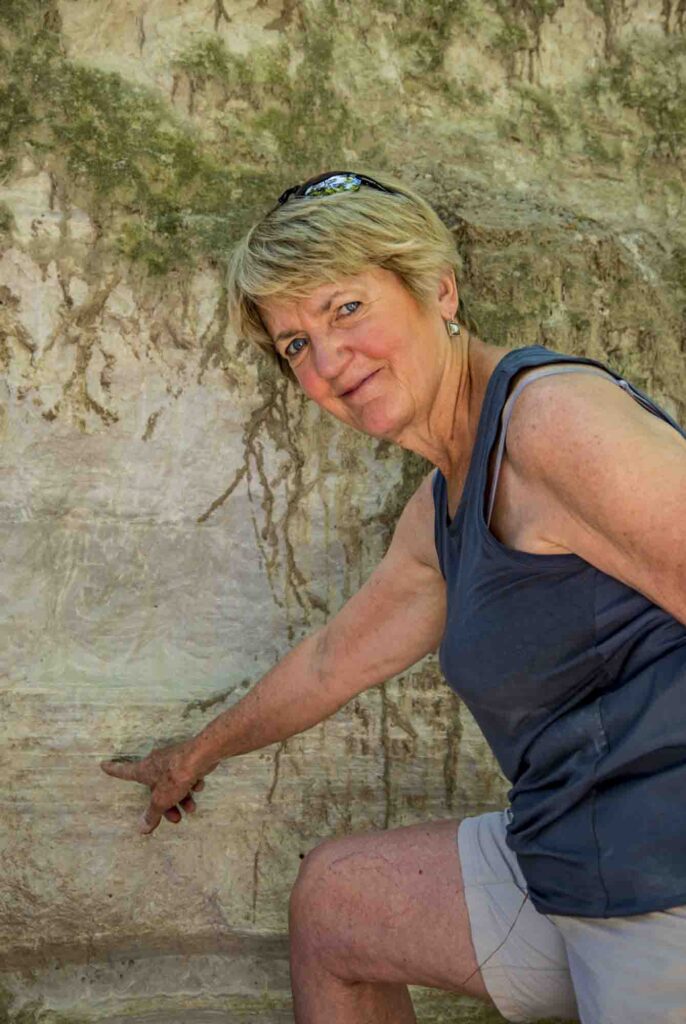
NEBRASKA: THE GOOD LIFE
THE OGALLALA and WHOOPING CRANES
KLX IGNORES SOILS and FARMING
FAMILY CORPORATIONS v. “BIG AG”
WATER REGULATIONS v. KXL
PERSONAL IMPACTS of EASEMENTS
KXL PRESENTATIONS v. DOMINA LAW
LEGAL EASEMENT CONCERNS
EMINENT DOMAIN: A CONSTITUTIONAL ISSUE
THE COMMITMENT of ACTIVISM
PRESSURE to SIGN EASEMENTS
NO RESPECT for LANDOWNERS, NO NEED for OIL
PUMPING STATION in STEELE CITY
KSL – as PARTISAN as DAPL
A NUCLEAR WASTE DUMP SITE – A TEMPLATE
FAITH in the LEGAL PROCESS
Key Quote In 50 years, we’d have a mile of rotting pipe they abandoned, leaving us responsible as that rotting pipeline’s oil ultimately contaminates the ground. The digging cost itself is more than any farm operation could absorb. – Jeanne Crumly
All images © Alison M. Jones, unless otherwise noted. All rights reserved.
NWNL I understand Bold Nebraska is the Nebraska organization coordinating legal efforts to stop TransCanada’s Keystone XL Pipeline. If allowed, it would run across your farms and rivers, and seems certain – at least locally – to inevitably cause leaks..
JEANNE CRUMLY Those with Bold Nebraska are “our heroes.” They have a coordinated effort, to which I have pitched in and done some things. The most interesting task was to review profiles of 48 landowners and legislators also who’ve been involved in this pipeline fight. I now have a real perspective on the human part of this battle.
NWNL I often say, “The water story is a people story,” Here in Nebraska, it’s also a land story.
JEANNE CRUMLY It’s story of responsibility and a clash of perspectives on the privileges we’ve been given: managing land, living on land, enjoying it and accepting responsibility for it. Yet, the fight we’ve taken up is totally outside our nature and our comfort zone. I’d rather be watching ballgames with little grandbabies. But we seem to be called into this fight, and so we’re taking off the gloves.
SHARYN TROESTER I agree. My husband, Dave, and I farm in this area, and we have four quarters that the TransCanada pipeline will be crossing. [Editor’s note: A quarter is a 160-acre square piece of land.] For irrigation, we have center pivots, each of which has its own well to provide irrigation from the groundwater.
Nebraska sits over the Ogallala Aquifer, as do the Dakotas, Nebraska, Kansas, Oklahoma, and parts of Texas. This water is our livelihood and Nebraska’s #1 asset. It provides our livelihood, and we’re trying to protect that.
NWNL How long has your family owned the land?
SHARYN TROESTER My family is my husband’s family. They’re “recent people”, here since the ‘70s. But the strong spirit goes way back, despite perceptions of people on the coasts that the Midwest is “flyover country.” Well, we’re also the country’s breadbasket! I know that California produces food, but we do too — we’re just not quite as well-known.
JENNIFER TROESTER I married Sharyn’s son and teach at the public school in O’Neill. My husband, Aaron, farms with his father, who came back and decided to make his life here. Now, our 5-year-old son, Barrett, wants to come back and farm. Plus, Barrett is very concerned about the future, and we are too.
Even if the pipeline is fine for 50 years, what if it breaks, or leaks or has other problems when our kids are farming the land? KXL is a concern for generations to come, so I’m trying to educate myself whenever able. Jeanne and Sharyn are very knowledgeable about what’s happening, and I’m trying to learn too.
JEANNE CRUMLY I want to share my heated debate with our governor. About 8 of us had a half hour to speak with the Governor. Our friend Greg Wolmer had slides to show that the area of highest irrigation density is the area of highest KXL resistance.
The people most intimately connected and aware of water’s vital role here are those who are saying, “Hold on, hold on, we need to rethink this.” They’re among the longest landholders. Even if you’ve only been here 50 years, if you have a son and a grandson, you have a legacy. My father-in-law came in 1911 from Texas and never had shoes. So, my husband’s family has had the land over 100 years. That’s the story all along the route. We’re of multiple generations, with a backward perspective of where we all have come from. And we have a vision of where we’re going.
Our land won’t be sold. Our land is not an economic commodity. It is our birthright; and our responsibility is stewardship. “Maintain it, manage it, improve it, pass it on.” The mistake TransCanada has made is thinking they could throw a few dollars at people, and we’d just roll over. Well, farmers aren’t in the business for dollars. They’re in for lifestyle. We’re in because it’s our responsibility. If we wanted dollars, we’d sell the land and live grandly the rest of our lives. That’s not what we want.
SHARYN TROESTER Adding to Jeanne’s point of view on “passing it on,” farming is just not a job. We have a passion. We love the country. I grew up in Chicago. When I met my husband, I learned the Nebraska slogan: “The good life.” And it has been “the good life.” Our responsibility is to keep “the good life” for the future. That’s why we’re arguing over this pipeline – to keep Nebraska safe and clean. It’s not a job, it is our passion.
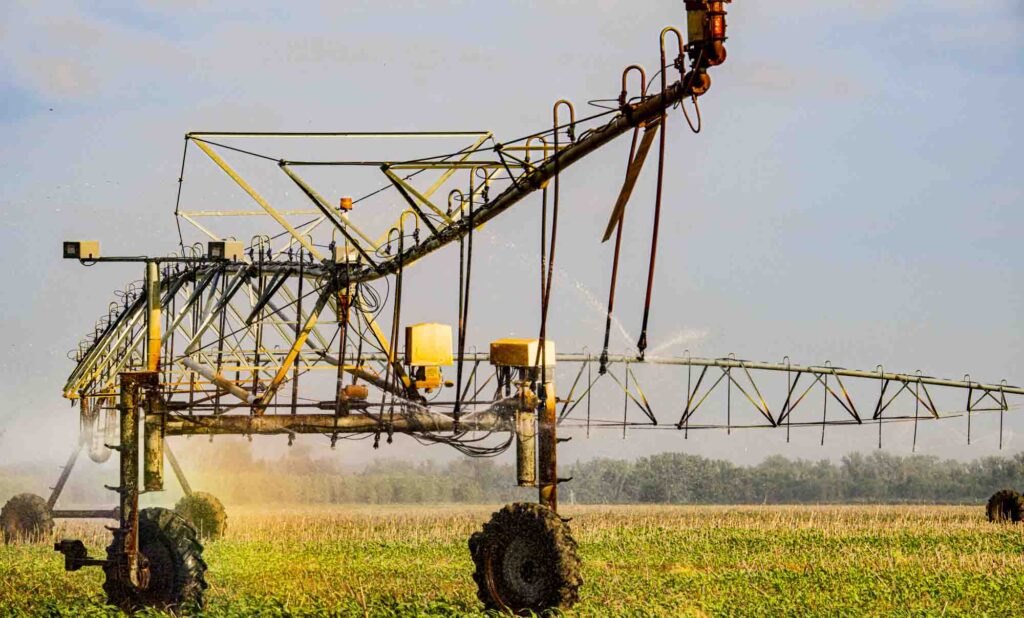
JEANNE CRUMLY Our high use of irrigation here is because of this sandy soil that needs water. Because of the aquifer, we have the sandy soil; and the aquifer gives us the irrigation water we need. This is a “recharge area.” The sandy soil cleans the water, lets it flow back into the aquifer, and then we can utilize that water. It’s a “water cycle.” Many think the irrigation water goes up into the air and dissipates. But, in fact, it’s an effective “water cycle.” … Unless we mess it up.
NWNL On the kitchen counter in front of us are 3 Mason jars and 2 baggies. What are they?
JEANNE CRUMLY They’re pickle jars! I got them because the lids don’t fit Mason jars. We’re frugal people here. We don’t waste things – which is part of our argument.
Yesterday, I called a variety of people asking for soil samples from their farms. As you see in these jars, we have very sandy soil. I wanted to illustrate that that sandy, porous quality of our soil, since it’s the porosity that makes our water supply vulnerable to any contamination. These samples exhibit some interesting factors.
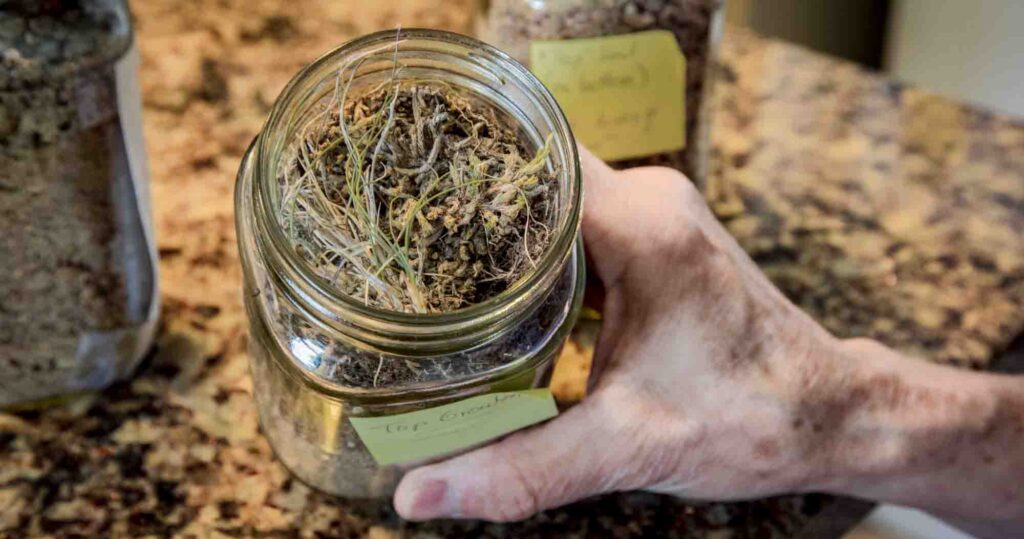
I have many plastic bags from people who gave me their soil as samples. An 80-year-old couple, Earl and Bev Miller, dug their soil, but they did a unique thing. They dug down 14 feet to show the layers of gravel and sand. If you poured water in there, it would seep through mighty quickly. So, their jar represents those 14 feet.
Irrigation is not just a surface thing. If a pipe were to be buried, it would be buried in this – and sitting in water. This jar is the soil at the surface. This is from a pasture. This is Nebraska prairie at its best, virgin prairie. The Audubon Society is interested in this virgin prairie because whooping cranes have been sighted there.
NWNL Can you quickly comment on the whooping cranes’ endangered status. I didn’t know they flew through here,
JEANNE CRUMLY When I moved here, I worked a little bit with Sierra Club and Grand Island documenting their migration through Nebraska. At that time, there were 7 whooping cranes left, so there was a massive effort to restore the whooping cranes. Now their numbers may be up in the 100s,
This flyway for both Sandhill and Whooping Cranes used to be 300 miles wide. Now it’s about 40 miles wide. Earl was called because whooping cranes have been identified on their ground, which has streams bubbling up out of the ground since the aquifer is that high there.
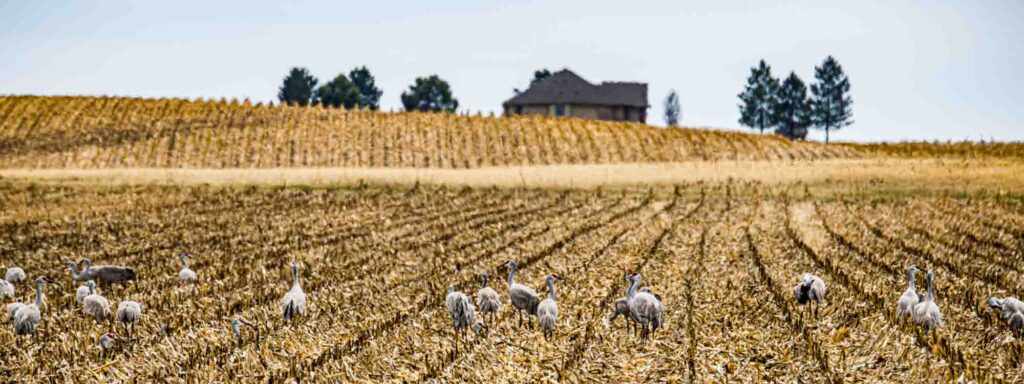
JEANNE CRUMLY This is what our soil looks like. The topsoil is darker that the sand below. TransCanada has made a shallow hollow promise that the land affected by the KXL Pipeline would be restored perfectly. But how do you restore this? If it’s a windy day, it would blow away. But TransCanada refuses to commit to successfully restore soils in their easements. They’ll replant, but they won’t put in the easement that it will be restored. They certainly won’t say “successfully.”
JENNIFER TROESTER Right! That’s Aaron’s biggest concern. He just said this morning that one of this biggest concerns is that once they dig up any soil to put in the pipeline, that soil will never be the same. It’ll never be as fertile. It’ll take hundreds and hundreds and hundreds of years. He said that because it will be so heated around the pipeline, the soil will just never come back to what it once was.
NWNL Oh, I didn’t know that once the pipeline is in and operational it would heat in the area around it.
SHARYN TROESTER It has been written that the tar sands produce the dirtiest oil. Why it’s called oil is a big question for many of us. Imagine goopy tar…. that’s how oil comes out of the ground in Alberta’s Tar Sands region. They add very toxic chemicals and heat it to make it liquid so they can push it through 36” pipes. That creates a lot of friction, which creates heat, It will be difficult to grow crops in heated soil.
As Jennifer said, once sandy soil is disturbed, chances are when wind blowouts come, it just gets sandier and sandier. Then it’s hard to reestablish anything on that top layer. Ranchers have even put tires in the pastures to keep soil from blowing off.
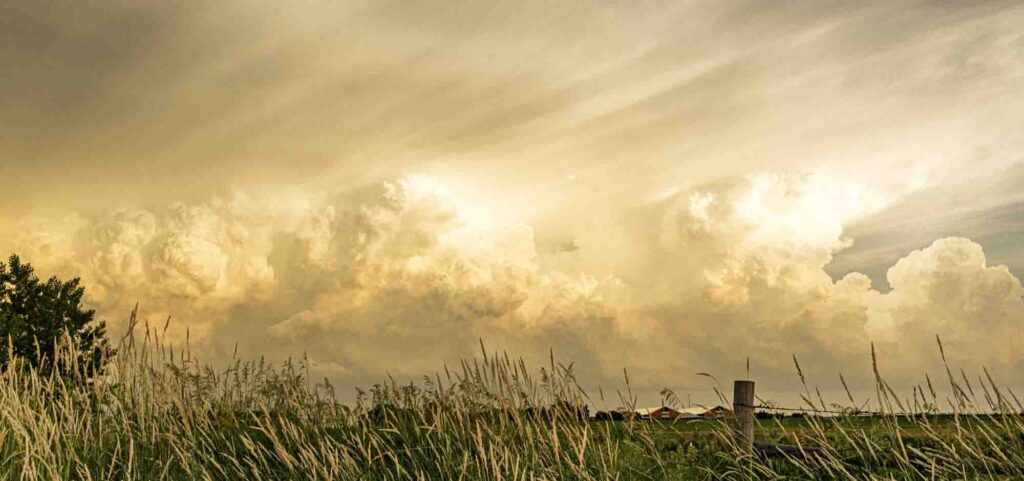
SHARYN TROESTER Once that soil is disturbed, we have a lower growing capacity. Yet, the pipeline company in Canada refuses to restore it. They’ll just keep the pipe in the ground. If they or we must remove it, poisonous sediments in the pipelines would just be left in the soil.
NWNL How much land on either side of that 36-inch pipe will be disturbed?
JEANNE CRUMLY Who knows? They give themselves so much leeway and so much vagueness in the easement. According to TransCanada, the lifetime of the project is 50 years – when now-5-year-old Barrett and my grandson, Jake, will be our age and doing this. 50 years isn’t a long time.
Our grandson is studying ag right now. He’ll be here. In 50 years, at the end of that project, TransCanada, or whoever owns it by then (since they’ve given themselves license to sell to anybody) can walk away scot-free. They’ll abandon the full cost and liability of that rotting pipeline in the ground. We already know you can’t sell ground that a gas station’s been on, because there are underground tanks. The cost of removing 1 underground tank is infinitely more than the cost of the ground and the building.
In 50 years, we’d have a mile of rotting pipe they abandoned, leaving us responsible as that rotting pipeline’s oil ultimately contaminates the ground. The cost of digging it is beyond anything that any farm operation could absorb.
SHARYN TROESTER The expense would be tremendous.
NWNL To make this issue more tangible, how much land will be affected? How many miles wide and long is one square, that you call a “quarter”?
JEANNE CRUMLY Our quarter is 160 acres: ¼ of a mile by ¼ of a mile. That section term from dividing townships ranging from Indiana on. It’s a very organized system. In dividing them, they labeled every section. Then every section is divided into fours, as “quarter sections.” The Homestead Act allotted each landowner a “quarter section” of land, except in Holt County and parts west.
This is the last part of the country to be homesteaded because it was the poorest, least productive soil. One couldn’t survive on ¼ of 160 acres. So Moses Kincaid—you saw the Kincaid Building in town—proposed the idea that in this ground, a settler had to have 640 acres, four quarters.
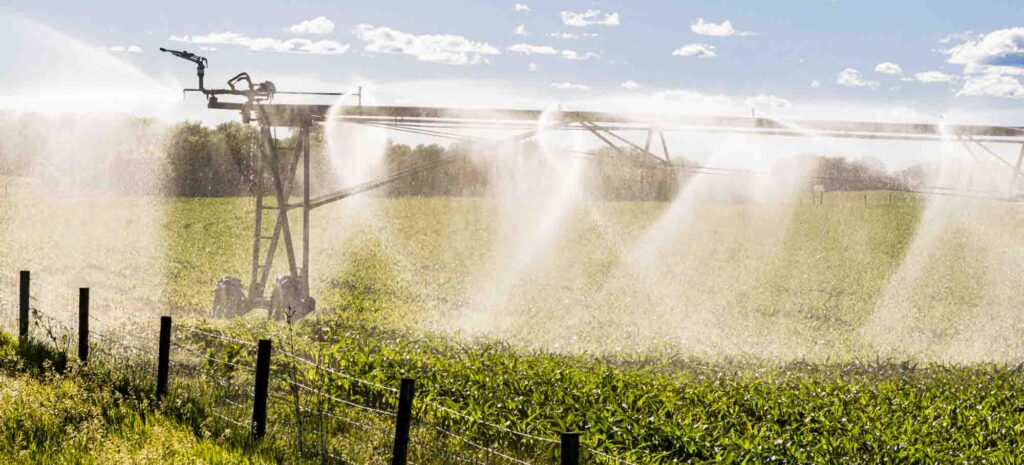
JEANNE CRUMLY Holt County is also the seed bed of center-pivot irrigation. Some of the earliest center-pivot irrigators started here because it is so critical. If nobody believes the soil is thirsty, that history tells you so. As you photograph, you’ll notice we’re early in the planning season. You can see rows and a bunch of rubbish left from last year to prevent wind from disturbing and blowing away.
NWNL The agriculture here is what’s called “no-till” now?
JEANNE CRUMLY Yes. In this area it’s relatively new, maybe the last 10 years. But it has been adopted, absolutely. Addressing productivity, you might ask how this sandy soil can be that productive? Well, we’ve got the water.
We grow more popcorn in Holt County than anyplace else in the world. We’re the popcorn kings. You’ll see Morrison popcorn in Queens, NY. We also grow potatoes here successfully since they only grow on sandy ground. The minute they dig those potatoes out, they’ve seeded a rye crop on it. They’re watering it now, due to the fragility of the soil. We grow corn, popcorn, soy greens, cucumbers, edible beans – lima, pinto, kidney and navy beans. We grow tomatoes in enclosed greenhouses.
So, there’s richly varied food production – and we grow cattle! We’re the cattle kings and queens.
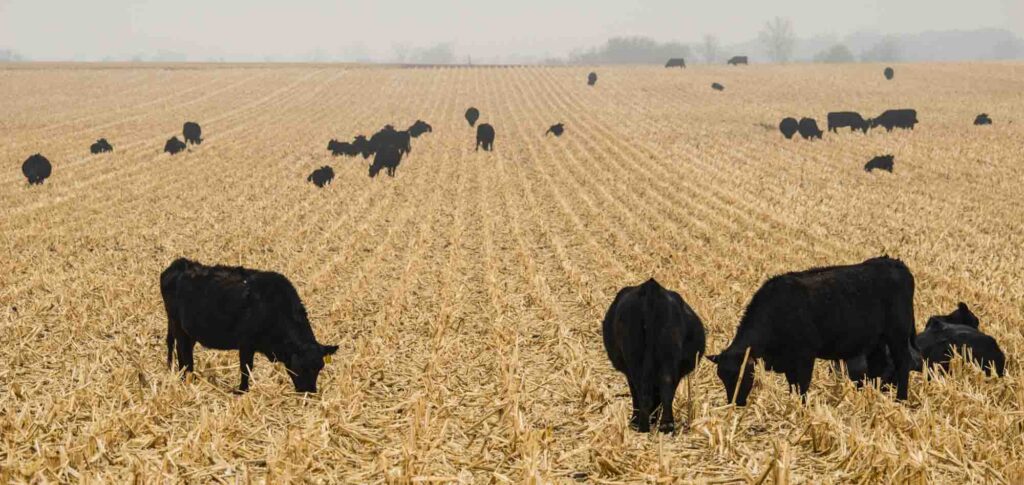
NWNL Aside from Keystone, what are your challenges today?
JEANNE CRUMLY I grew up in eastern Nebraska, where it has heavy, rich ground. So, irrigation is optional there. They might irrigate only 2 or 3 times a year. Well, the cost of irrigation is at least $600 a day, per pivot. So here, if you irrigate 75% of the season, the irrigation cost is enormous, especially compared to input costs, i.e., irrigation costs. In Iowa, Illinois or eastern Nebraska, they don’t have that irrigation cost. But we live on a very small margin. That’s why people are more diversified here.
Farmers in eastern Nebraska and the other states put seed in the ground, and go on vacation, and harvest when they come back. Here, we manage pivots 24 hours a day all summer long, so that smaller gain is why my husband has cattle; thus two incomes.
We also have enormously high property tax. We have huge input costs. We have wicked weather to contend with. We’ve already had 10% loss this year on some of our fields because of hail. With last night’s tornadoes, everybody was biting their nails over losing all our crops. It is a dicey game. So why do people keep doing it? Because it’s a calling. It’s a calling.
SHARYN TROESTER That’s very apt. I agree.
NWNL You could still be a farming family and enjoy that good life in eastern Nebraska where it’s easier. Why are you here?
JEANNE CRUMLY Because there’s no land available, for one thing. And our roots go deep. Pictures of our native soil show roots that are three feet deep – as deep as the pipe will be. That’s a metaphor for our human roots.
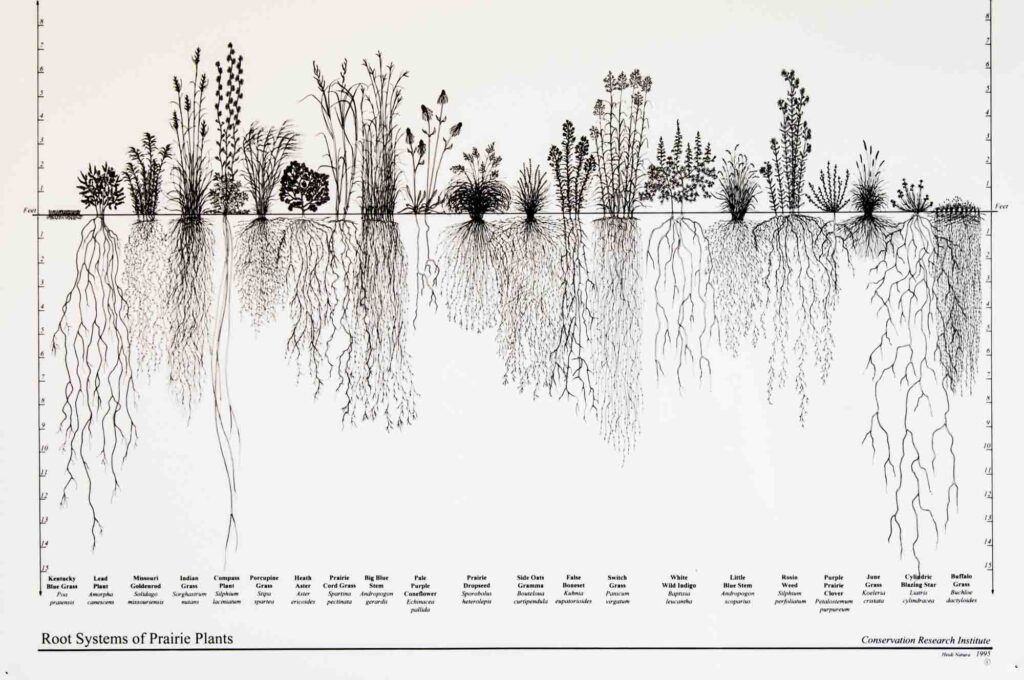
NWNL I have seen that depiction of deep prairie roots. In Cedar Rapids, Iowa, Wesley Jackson and his daughter Laura have done incredible research and interesting books on the prairie. She’s at University of Central Iowa and took me into the laboratory, where prairie grass roots were hanging and drying. She explained the varying lengths of the roots. So, the moment you said your prairie roots go deep, I noted that visual metaphor before you mentioned it.
JEANNE CRUMLY My husband’s land is the land his great, great grandfather came to. There’s a little bitty surface pond of water that comes and goes. There’s always a little bit, but it varies, depending upon the season. That singular item is what brought them to that spot. So, when Ron checks his cattle, he’s in the footsteps of his father, of his grandfather, of his great grandfather. We can’t move to eastern Nebraska and just take that over there with us.
And now my husband farms with his grandsons. He passes along stories every time he takes them out. Together they fix fence and help in our “nursery,” where the baby calves are born in the spring.
NWNL What about the threat of commercial agriculture, often called “big ag”?
JEANNE CRUMLY We are “big ag.”
NWNL Hmmm. You consider yourself “big ag,” but you’re a family-owned business – not a corporation.
SHARYN TROESTER We are a family corporation, but not what many people think of as a corporation. We think of ourselves as a family-operated farm. Compared to people used to maybe 500 to 1,000 acres, we have a lot of acres. But it is still difficult to eke out a living. Yet, we’re not any less operative or less feeling regarding stewardship than you think of coming from a person with an 80×80’ garden.
JEANNE CRUMLY I think economic standards might call you a corporation; but, in fact, you’re an operator-owner. The difference, in terms owning a Culvers store, is that whether you’re farming 19, 50 or 100 quarters, if you’re the one digging your hands in that soil every day, you have a different sense of responsibility.
Individual farmers have had to become “big ag,” because the margins are so small. It’s the Kincaid Act gone large. If they have 160 acres, they can’t make enough money to live on. Ag margins are too small and too unpredictable. So, you get a second quarter of ground.
If you can do two quarters with the same equipment, you have a better chance of making a little bit more profit. In the ag environment, that’s what is sustainable, what allows you to make that cashflow to match your labor force. There are a lot of people who want to get bigger, bigger, bigger. It costs more in equipment, and they crash. It is a fine balance.
SHARYN TROESTER I think “big ag” is a misnomer that refers to acres. It could still be “small ag” in that you might have a family with three children, and they’re all working, but they cover a lot of ground. In print, you’ll have so many acres – maybe 8,000 acres. “Oh, my goodness, that’s big ag!” But you might only pay three or four people working for you. To me, “big ag” right away makes you think huge corporations, but that may not necessarily be the definition. It’s semantics.
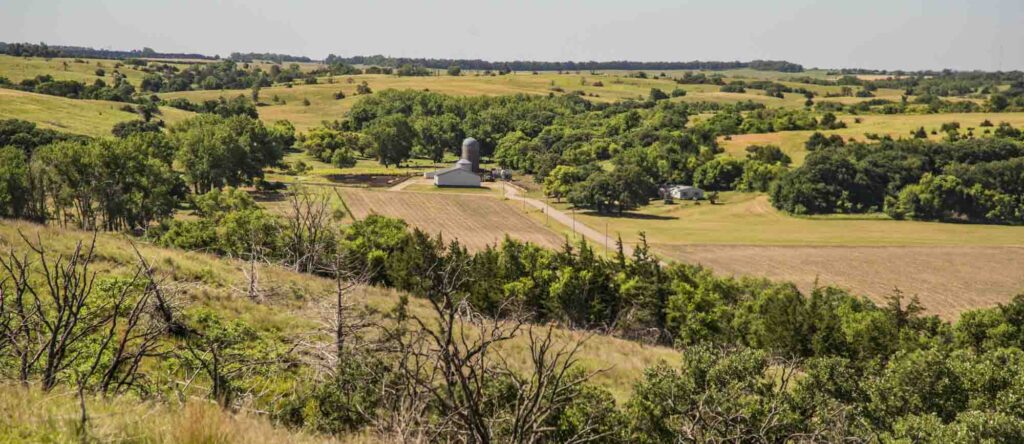
JEANNE CRUMLY Also, the negative connotation of big ag is absentee-ism, where you’re not doing or being part of what you are invested in. Instead, it’s simply a cash business thing. We’ve got a lot of big farmers in our county, but they’re also deacons in their church, on the school Board, and coaching Little League softball. Big farmers can be invested in their community and stewardship of their land; and they can hold that perspective of responsible maintenance, management rather than simple exploitation. There are critical nuances to the terms of big ag.
NWNL Not only that, those big farmers in the community are also voters, as opposed to distant corporate managers..
JEANNE CRUMLY And they’re also voters.
NWNL If something’s coming down the pipe — oh, that’s a bad metaphor. I didn’t mean to use that! If something’s about to happen that the local big farmers don’t like, they can go to the polls.
JEANNE CRUMLY I think the whole mentality of rural Nebraska is neighborliness, friendship, honesty, and $1,000 deals done on a handshake. What you say is what you are, in most cases – not always. The challenge is that if people hear advertising, there’s an assumption that it’s true, and I think that’s exactly where we are with TransCanada statewide. They have flooded the airways with blatant lies and misinformation, so people say, “It can’t be that bad,” because they’ve been indoctrinated. We need to push Nebraska rural communities to think beyond that surface level; to have a little bit of suspicion; and to investigate issues a bit.
The challenge for this generation of educators is to create an inquisitiveness. I think that’s our challenge nationwide. But particularly here because we have that fundamental honesty. When I called people to get soil samples, one guy said, “What good is that? You could be digging it up anywhere?” I answered, “But we’re not – we’re honest.” It’s their responsibility to try to prove that we’re wrong; and they won’t because we’re honest. We don’t submit anything other than our bedrock truth.
NWNL What challenges, outside of the pipeline issue, concern you as farmers and water users here in rural Nebraska?
JEANNE CRUMLY Water regulation is becoming a huge issue, and it should be. They’ve instituted a moratorium on wells here, because so much water is pumped from the ground and a lot of land has been developed that shouldn’t have been. With the moratorium, you can either get in a lottery and maybe you’ll be one of the wells to be developed. Or else you don’t get to develop land. You’ve seen a lot of undeveloped quarters that are just pasture, and probably there’ll be more of that. But if water regulations restrict a farmer’s ability to irrigate as he sees fit, then without it, a 110-degree day in July with a 50-mph wind will burn that crop in a day.
SHARYN TROESTER The leaves curl. They wither. They hang their heads down.
JEANNE CRUMLY They’re sad.
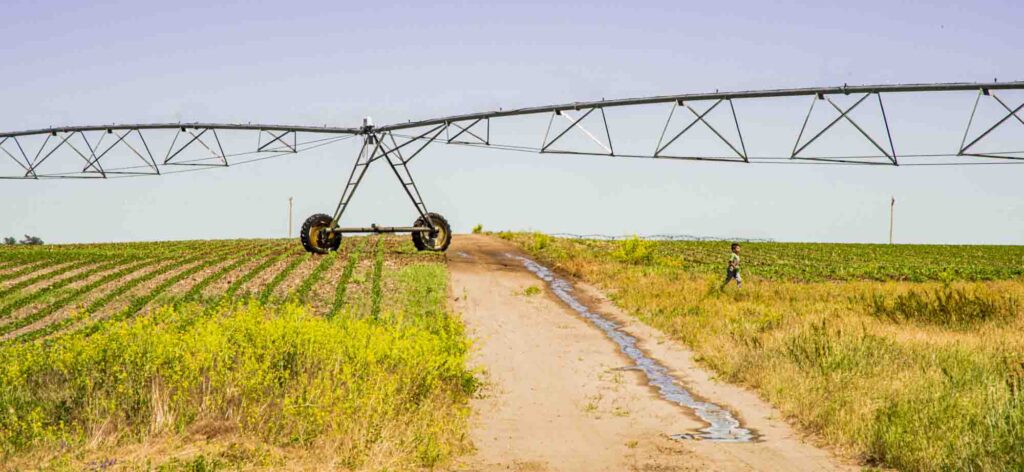
JEANNE CRUMLY That balance between water management and water accessibility is always a challenge. At Nebraska ag shows, public radio tries to cover ag things fairly, but there’s that taint that farmers are reckless in their use of water. Yet, with the costs and consequences, they must be so strategic. I know out here farmers are quite responsible and don’t want to taint the water.
So, yes, water management and water philosophy is an issue.
SHARYN TROESTER That’s what I read too.
JENNIFER TROESTER Even both my children, Julia , age 17, and Barrett, age 5, have asked, “What if oil leaks into the Ogallala Aquifer? What will we drink? Where will our water come from?” They’re concerned about water. Barrett even asked me the other day, “Will we have to move to a different state if we can’t drink or use our water?
Julia investigated the Keystone pipeline, as an 8th grader, in a unit on “Writing to Change the World.” She has followed things to see how KXL and water issues will affect us long term. Even though she doesn’t want to come back and farm, she’s concerned about the land and the family farm. They’re concerned about what they’ll drink and what the future will be if any of that tar sands leaks into the water system. As a teacher, I know that’s a huge concern for a lot of students, not just my kids.
SHARYN TROESTER Life depends on water. Water cannot be manufactured.
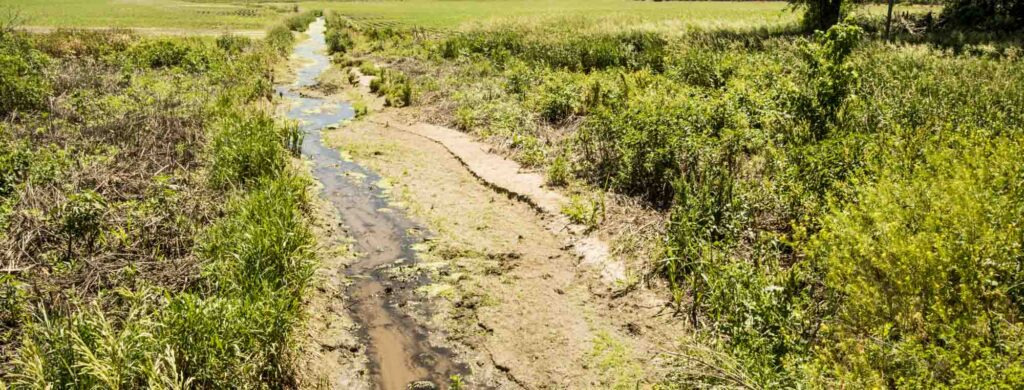
JEANNE CRUMLY And if you read the “Worst-case Scenario Report” that TransCanada had to do, they acknowledge there would be 11 leaks.
NWNL Eleven leaks?
JEANNE CRUMLY University of Nebraska in Lincoln said 91 possible leaks. So, estimates are 11 or 91. And the points of greatest vulnerability are points under waterways, because there are bends in the pipe.
At the last hearing, they talked about leak detection, which they can only detect over 2%. Apparently, 2% of 850,000 gallons is a lot of leakage that can’t be detected, and the leaks that have been detected have been visual reports by passersby or landowners.
So even if we are disposable, Omaha and Lincoln and Grand Island and Fremont aren’t disposable, and they’re on waterways.
NWNL Jennifer, you’ve spoken for your children about their concerns and questions about KXL. How would it affect you, Jeanne, if this pipeline went in, whether psychologically, economically or just on a day-to-day basis?
JEANNE CRUMLY Well, we spent $100,000 just a few years ago to put in a tiling system.
SHARYN TROESTER We did too. To explain tiling to non-farmers, imagine we’re sitting on a lake, except the lake has an uneven surface, so it’s higher and lower in certain places. Or sitting right at the surface. On a field, we can have soil like this, but parts of that field will drain out, because of those little water spot. So how do you irrigate if some parts are saturated, and some parts are dry? Ancient Egyptians did tiling. You bring in a pipe system that carries the water to a more desirable location. It’s expensive, but it works.
We’ve had wonderful success with tiling, but guess where that tile is? Right in the route of the pipeline. So recently, that tile became plugged. We called our repair guy who came and dug to repair whatever the blockage was. If it was TransCanada’s pipe on our land that was plugged, we would have had to call TransCanada at their office is in Norfolk or Omaha to first have somebody come out here and say, okay, yes, you can dig on your own ground.
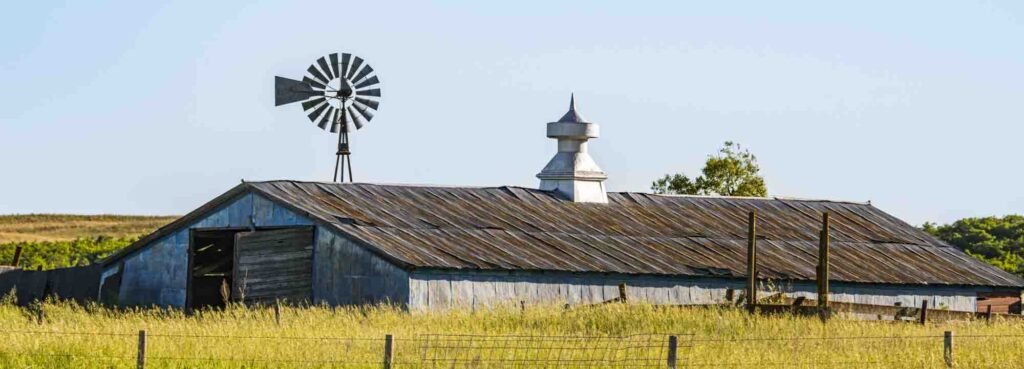
NWNL So you would need permission from TransCanada.
JEANNE CRUMLY Yes – to do anything on your own land. TransCanada would have the option to access that ground anytime they ever want to without your permission, but you can’t do things without their permission. TransCanada has the option to have you shut off your irrigation system anytime they want to, because they’re doing maintenance, even if it’s that July 10th day with 110-degree weather.
They’ll say, “Oh, we’ll work with you; but they haven’t worked with us yet. So, the reliability of that statement is zero. They take all the decision-making and write it into their easement; and they give us none.
NWNL How much land will TransCanada take over with these easements on either side of the pipeline, the 36-inch pipeline?
JEANNE CRUMLY The easement is a 100-feet-wide strip, 50 feet on either side of the pipe.. But they give themselves access anytime they want, so they can go across your land any way they want and however they want to get to that with their machinery – with whatever machinery they want. It says even in Brian’s easement, if they decide to tweak that a little bit, they can put it anywhere they want. That’s before they ever dig it.
NWNL I heard from Bill Blake that they get an easement, but it covers your whole property; and that they can tell you they’re going to put it, and then change their mind whenever they want, perhaps putting it in a corner which might be your home.
JEANNE CRUMLY Right.
NWNL I guess they must keep away from your actual house.
JEANNE CRUMLY Impacts on the buildings is less important. More important, are impacts on the wells. TransCanada’s plan puts its route right on our well, which fries me beyond everything. This was when I was done with TransCanada. We went to every information meeting. We came into it neutral, but they trained us to despise them. The last meeting we went to, there were only about 8 people, because some had signed, and others were so disgusted they wouldn’t even meet with TransCanada.
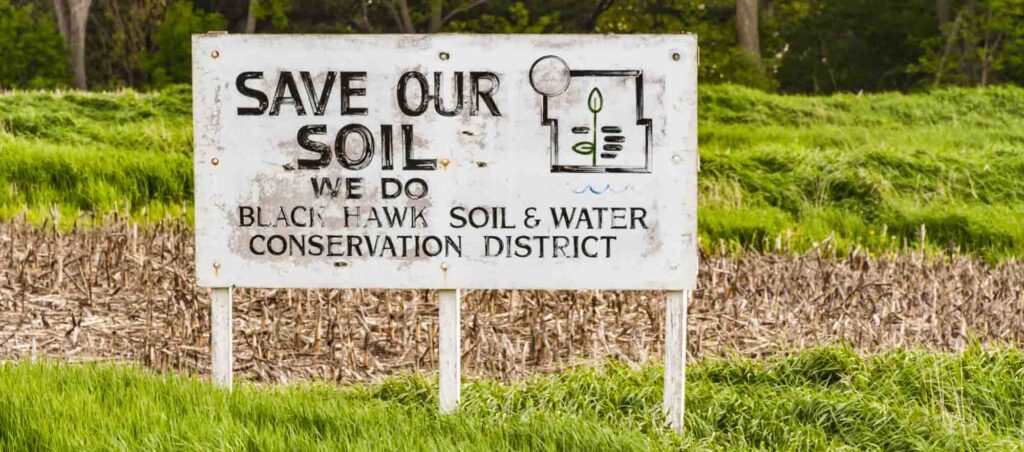
Jeff Raugh, the front man, brought all these books to explain to us how safe the chemistry was – not the pipe. The chemicals were safe he said because they were all biodegradable. That was his pitch. My husband’s a biology major, and he’s no fool. At their meetings, we’re always polite, although our little protest was we never ate their food and never drank their beer. We listened to all they said, and Ron responded, “Okay, you’d be 400 feet from my well. Suppose there’s a leak and you taint my well? “No problem,” Jeff said. “You just run that out through our system onto your field and it will dissipate,” That’s TransCanada.
NWNL And what opinion did you have regarding that response?
JEANNE CRUMLY That would kill everything. Would you change oil in your car and pour the oil on your yard? That’s the level of trust any of us in the US should have with this company. It’s why the industry calls them “the dirty dogs.”
NWNL Those are turning points in your opinions. Take a slug of coffee and tell how TransCanada first got in touch with you.
JEANNE CRUMLY We got a phone call at about 9:30 at night, 7 years ago, 2010. Then they changed the route in January of 2011. Department of Environmental Quality was using TransCanada maps on their website. That tells you a little bit. Our land was designated “sandhills.” Then in January of 2011, they used a different kind of map – a tall-grass prairie map, and sandhills were designated differently. So suddenly our land wasn’t in the sandhills. When they said they moved it off the sandhills, it was that they changed the naming on the map.
I was teaching at school when the land agent came out. Ron said to the agent, “We’re not signing anything. Leave the paperwork. We’re taking it to our attorney.” Our attorney said, “Don’t sign anything. Whatever you do, give it to Dave Domina, who has filed lawsuits. He’s the most knowledgeable one about this.”
Shortly after, there was an informational meeting in O’Neill’s community center. They were all in their slick shirts and khaki pants, wandering around answering questions. We were still in shock. I wanted to run screaming as I listened to these guys talking, because answers to real questions were so slick and so dismissive.
“What about heat?” one older farm wife asked. “Shouldn’t there be heat through that, and what are the implications?” People knew their ground and the science of agriculture. The answer was there wouldn’t be any heat. I didn’t know if that was true or not, so I called my son-in-law, who is an engineer. He quickly responded, “Oh yeah? Of course, there’s heat.” That didn’t reassure me that I wanted to work with these people.
At that same meeting Dave Domina and Jane Kleeb offered a landowners’ meeting. Dave said, “This is never going to be about the money. It is about easements, easements, easements.” He said they must remove it from the ground. They must give you annual payments — or the state should get a penny per barrel, or something. There must be a continued commitment to the stakeholders. Then he said that they were forming a group, which became the Nebraska Easement Action Team. We joined that. Then Jane Kleeb stood up. I’d have gone through bullets after I heard her speak because she was so inspiring. She was hopeful. She was energetic. I knew I wanted these two people on my team.
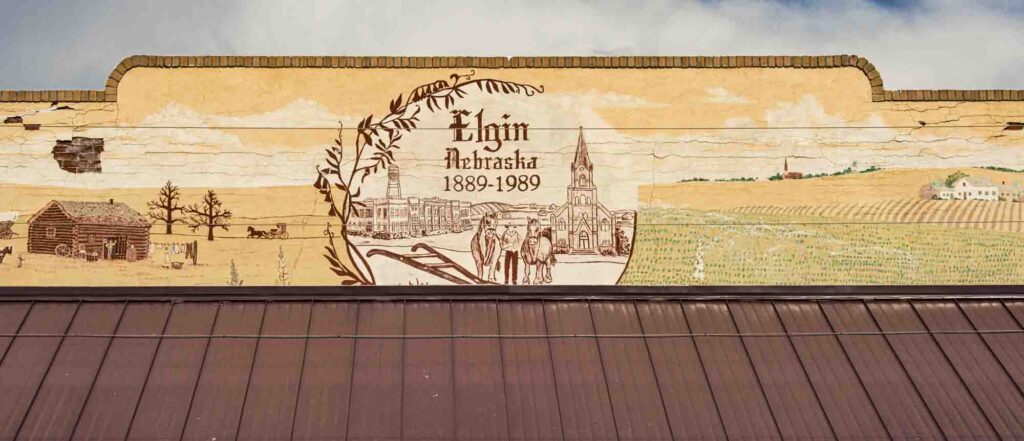
JENNIFER TROESTER My dad owns land in Elgin, 80 miles southeast of here. He’s very aware and concerned. He watched the wind towers come in, and he’s paid annually. He’s concerned that these KXL landowners would only be paid once. The other questions he brought up were who owns the oil that’s going through, and who’s getting ? He said, when you start giving your easements on U.S. ground to other countries like Saudi Arabia or China, they don’t care what happens or what’s going through there. He said, “My biggest concern is that KXL has no stakeholder-ship in this land.”
Foreign countries don’t care what happens to our waterways, but we depend on them. He said, “Once you start giving up American land to other countries, there is a huge red flag.”
JEANNE CRUMLY That’s true and a perfect parallel. The windfarm north of us by 5 miles is Nebraska’s biggest windfarm. Some reaction is negative, because of how it looks on the horizon, or the sound. But landowners are paid $10,000 every year each is in operation. At the end of its 20-year lifetime, they’ll renegotiate or remove everything, so you have your land back. That doesn’t exist with this. But TransCanada will give us only one payment. Plus, they decide everything they can do.
NWNL That seems critical.
JEANNE CRUMLY TransCanada offers a one-time payment, and, in our case, the first payment offer was $8,900. To put that in perspective, it’s less than an irrigation tire; but they claim that easement in perpetuity.
NWNL What’s the length of pipe they’d put in across your property?
JEANNE CRUMLY We would have half a mile, probably. We lose lots of control over our fields; but, beyond that, they would leave liability on the landowner, at their discretion. So they can say, “Okay, there was a leak and you have a 5% liability.”
NWNL Why?
JEANNE CRUMLY It depends on what happens. We expect that 50 years from now, we’ll have 24-row planters…. We don’t know how big equipment will become, or how practices will change in 50 years. Will we have underground irrigation then? That would be ideal since less water would be lost to evaporation.
If a leak happens due to new technology, TransCanada can say it was our fault. Domina Law says the agreement should specify “intentional destruction” – typical language in such agreements. But TransCanada won’t accept that language. So, 5% responsibility on a billion-dollar leak means we’d be responsible for paying. None of us could survive that. We’d lose everything.
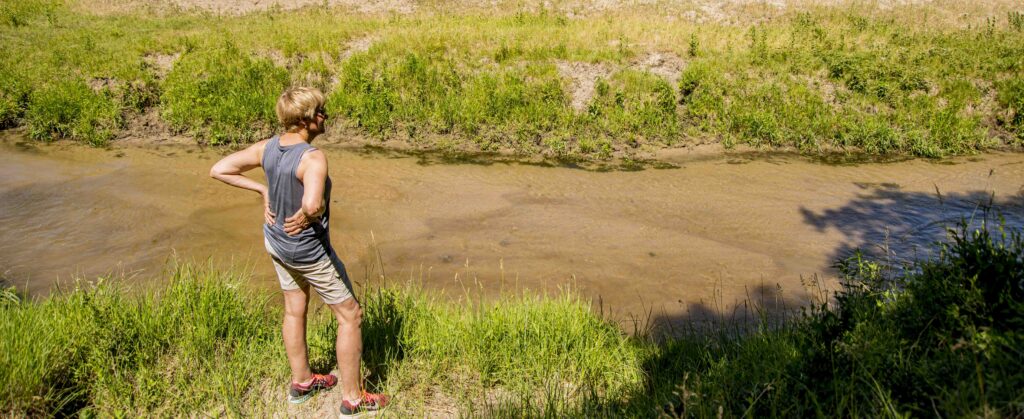
NWNL Have you listed your sticking points are with this easement agreement?
JEANNE CRUMLY I testified with my concerns. The key points are on Bold Nebraska’s website.
#1 We have a world glut of oil. We don’t need it, so there’s no point in this pipeline.
#2 We’re on the aquifer. Even a small leak can taint the aquifer. Even the Coast Guard says there’s no way to clean a tar sand leak out of the aquifer.
#3 They’re exploiting landowners and will give them inadequate protection.
#4 They bought strategic pieces of land, allowing them access to the aquifer. Conspiracy theorists say their goal is to take our water and sell it. They joke about that, but we don’t!
#5 It’s a foreign, for-profit corporation. Our state legislature has given them license to grab our land. That should concern every citizen.
NWNL What key points do you object to in the easement agreement they want you to sign?
JEANNE CRUMLY There are so many, and most are subtle, not industry standards. My son-in-law, who is an engineer, read them. On every page he highlighted 2 or 3 things that aren’t industry standard.
#1 The payment is inadequate.
#2 They take rights from the landowner by claiming:
–access at any time
–ability to route it differently than our original agreement
–ability to turn off our irrigation system (or have us do so) for their access
–ability to access it any way they want, and drive across fields
–no commitment to adequate restoration of land or successful replanting
**In fact, it’s impossible to restore land in a lot of the places along the route
Susan Donovan in southern Nebraska testified that they’ve spent 40 years restoring native prairie. Thus, in negotiations, they asked KXL to specify their responsibility for “successful reseeding” to save their 40 years of restoration. But KXL wouldn’t add the word successful.
NWNL It seems the big vulnerability you face is that, potentially, you are liable.
JEANNE CRUMLY That is a huge point. Dave Domina, our attorney, has argued this at the Supreme Court level. He says landowners should have no liability, except in the case of intentional damage. But TransCanada will not put that into the easement.
NWNL What course of action do you have to either stop this or mitigate its impacts?
JEANNE CRUMLY First I should explain the Public Service Commission [hereafter, PSC]. We perceive significant corruption, because when TransCanada first began lusting for our land, there was no pipeline routing procedure. It was important that the State write a pipeline routing procedure. In late-night and extra sessions, they established a method for routing pipelines as a guideline for PSC’s elected officials.
PSC would hold public hearings with engineering and environmental studies. Then they’d decide if the route was acceptable. All well and good. But in a late-night, secret session TransCanada presented an alternative, according to Jane Kleeb. That said TransCanada could go through the PSC, or to the governor. By going to the governor, the only evaluation was by the Department of Environmental Quality/ DEQ (appointed by the governor). If DEQ decided “yes,” it would pass. TransCanada went through the governor, who approved it. But that approval was challenged in court.
An action team of landowners, through Domina Law Office, challenged the State of Nebraska claiming that legislation was unconstitutional. It got to the Supreme Court, where 4 of the 7 judges favored the landowners. The other three said, “TransCanada hasn’t pushed it through yet, so nobody has lost anything, thus these landowners don’t have a standing. They must wait until their land has been condemned.”
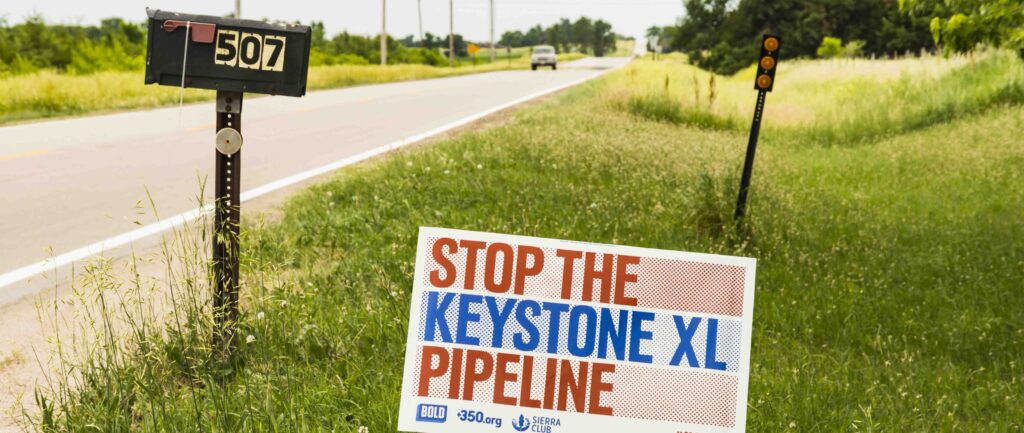
NWNL But a vote by 4 out of 7 is a majority….
JEANNE CRUMLY Yes, but as a Constitutional Amendment, it needed 5 as a super majority.
TransCanada condemned all our land. So, with the condemnation and the harm, we filed our lawsuit again. It went to court in Holt, York and Antelope Counties. Then it went to District Court, and Obama denied the pipeline.
But what we really needed was an answer from the Supreme Court. We wanted that legislation defeated. We were back with the PSC, our first option. The PSC has been incredibly responsible, gracious, attentive and respectful to landowners. At our request, they hosted a meeting in York. However, with all the security, it seemed we were facing the Posse Comitatus. [Ed Note: In Latin, “the power of the county” or a group of citizens called to assist the police in keeping peace]. TransCanada convinced local law enforcement that we were environmental terrorists. I am on their list, by the way.
The meeting ran from 9 am to 7pm. Landowners were probably 5 to 1 against KXL. Only union people were pro KXL – but PSC doesn’t decide on jobs or taxes, which are their concerns. We asked for another PSC meeting in Holt County, where many are elderly and won’t travel that distance. PSC agreed to a meeting here. They listened, and even after 7 hours, when a speaker wasn’t finished, they agreed to give her a little more time. I couldn’t ask any more of them.
I hope they heard our argument and really process it. They announced a third meeting, which is very responsive to our constituency. We’re hopeful we’ll prevail. In August, landowners will testify in a 5-day court case in Lincoln. My testimony is ready. We hope we’ll prevail in that decision. If not, we can appeal, and it could go to the State Supreme Court. I don’t know if it could go to the US Supreme Court, because then the issue would be eminent domain. Meanwhile, Dave Domina has been doing a great job as our lawyer, speaking all over the country, raising awareness of the risks of eminent domain for a for-profit company.
As long as TransCanada had eminent domain in their pocket, they didn’t have to negotiate in good faith or talk about removal of the pipe or any other payment system. They didn’t have to talk about landowner protection, since they always said, “Sign or we’ll condemn your land.”
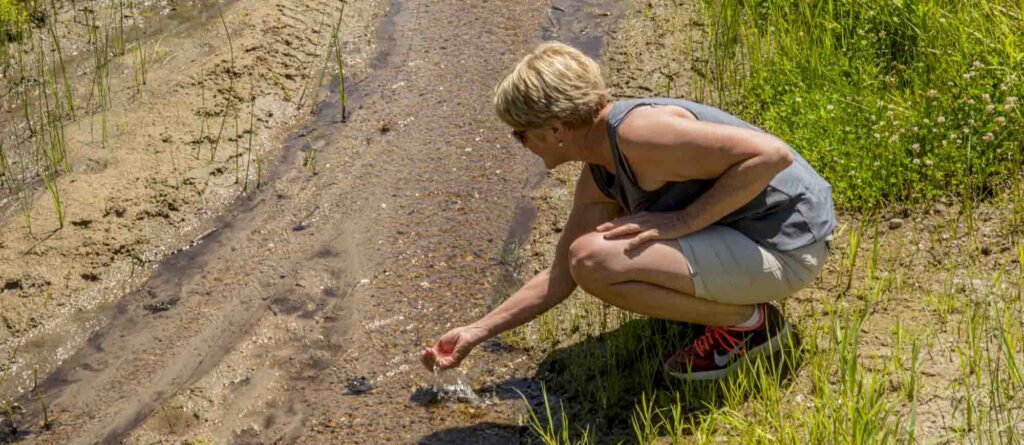
JENNIFER TROESTER My dad always said eminent domain was his biggest fear – not easements.
NWNL What is your family’s greatest fear about eminent domain?
JENNIFER TROESTER It’s about someone else getting profit from our land – and in so doing, they could destroy it. TransCanada could destroy the livelihoods of so many people. That’s our fear regarding a situation where eminent domain for entities in other countries profit.
JEANNE CRUMLY By its definition, eminent domain is applied to public use. We have given land through easements, not through eminent domain, We’ve negotiated easements for roads and lost land, but it was for a good purpose. The asphalt road that was on Ron’s land, and they moved it. That created a lot of disruption, but it made a safer road and improved tourist traffic. We have powerlines on our land—I’m sure you do too. Recently, we cut down a bunch of trees, so they could move the powerline to our side of the road where it was safer. These are cases of eminent domain where we have given up our private use for public use, when there’s benefit to the public.
NWNL It’s for the better good.
JEANNE CRUMLY Yes and it’s very logical. But when eminent domain is given so somebody can make more money, that’s immoral. It violates all understanding of private property, which is the bedrock of our economy.
NWNL Do you think Native Americans felt that way as the European white population took over their land?
JEANNE CRUMLY Absolutely, and thus the Native Americans have been incredible in partnering with Bold. They’ve said, “We know what this argument is.” Their passion is for preservation of the land and the water. You’ve heard about the Cowboy Indian Alliance, an unlikely alliance. Well, that’s what we need.

As well, landowners who are usually very conservative and outspoken opponents of government action are also supporting our stance. It takes something to get Nebraska farmers, usually with their nose to the grindstone, to take off a day of harvest or planting to testify in Lincoln.
The most significant and grueling testimony I gave was in Grand Island in March 2013. I was teaching, so took a day off work, losing my salary for that day. We heard a blizzard was coming, so we went down the night before and got a hotel room. Bold texted everybody to be there by 7:00 a.m to get a number. Despite a full-blown Nebraska blizzard, we did so, but weren’t let in until 11:00. We stood in the blizzard for four hours. Bold Nebraska had hot coffee and hot chocolate for us. They had line keepers, so others could stand in the line for we could go to the car to warm up.
We got in, and 7of the first 11 were TransCanada spokespeople. But we spoke until 9 pm. About 90% of us were KXL opponents! They thought we’d leave. After all it was calving time in Nebraska and all those ranchers should have been at home helping to deliver those baby calves in this blizzard. But KXL has gotten people riled up.
NWNL How does TransCanada when they contact you to sign over your easement. Do they just hand you a legal paper to sign? How do you say no? What is the process?
JEANNE CRUMLY Step 1, they ask for an easement, by bringing you 50 pages of paperwork with tabs on pages you are to sign. The papers are in legal jargon that we really can’t understand. If you sign it, you get a little check, and go on about your business. We didn’t sign it. We took it to our attorney to be correct in saying, “No.” Ten they sent us a 2nd packet with a different offer that says, “This is our last and best offer.” But we got several more. The last one was about 10 times more than the first – on the surface.
NWNL Meaning more in compensation?
JEANNE CRUMLY Well, that’s what they called it, with half as payment for losses of crop amounts. They – not we – arbitrarily decide how much they’ll give for losses. They have all the power. If they have eminent domain, we can say our crop is worth $4 a bushel, and they can say, “No, we’re only going to pay you $3 a bushel.”
NWNL What’s the difference in what they’d award you if you granted them the easement vs. what if you said “No” and they then just took it over via eminent domain?
JEANNE CRUMLY We don’t know yet. They’ll just start working as much ground as they can. They’ll have work camps somewhere along the way and they’ll have access to our ground whenever they get there, for as long as they need to be there. Plus, they can return at any time, and do whatever they need to do, for up to three years. They do not restrict how long that temporary easement will be, which is wider than the final easement. So, they could be on our land as long as they want to be.
SHARYN TROESTER With the eminent domain, as I understand it, a landowner can disagree and go to court to fight the eminent domain, but we’d have the expense of that legal fight.
JEANNE CRUMLY If our land is condemned, we can go to court only to argue the compensation from TransCanada. But we cannot then fight the condemnation.
SHARYN TROESTER The compensation probably would be minimal and only for the land value, not the risks, unless you have savvy jurors. If you have crops on there at the time, maybe. Otherwise, it’s just the land value, and, that’s decreased if a buyer wants your land, due to the liabilities of the easement goes to that buyer.
JEANNE CRUMLY We haven’t found out if they’d compensate us for crop losses. If we prevail over the PSC, then TransCanada would have to reroute and start the process over again. If we fail with PSC, then Domina could file an additional lawsuit on that eminent domain issue.
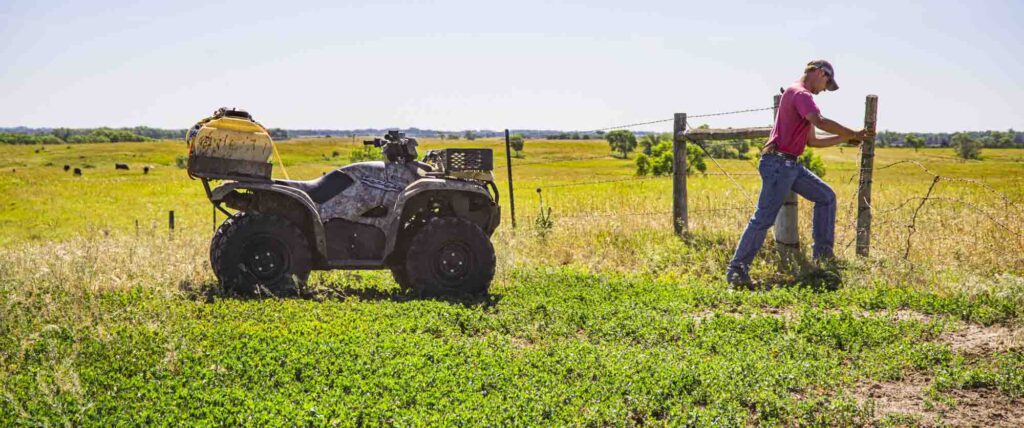
NWNL If TransCanada would listen, what would you ask them to do differently?
JEANNE CRUMLY I said to Jeff Raugh, the TransCanada spokesperson:
You’d have done better if you’d begun by coming to us landowners, respectfully. But you first went to legislators to buy off the Senate and the House. We can see how much money TransCanada has given every legislator in Washington, D.C. That money is traceable. Then you flooded the airwaves. Finally, you threw a little spit of money at landowners and told us to sign your paper. If you had come to us in the first place to commit a fraction of that money given to legislators to responsible stewardship, you’d probably have your pipe in the ground. You didn’t do it right.
He answered, “Well, maybe.”
NWNL Do you feel there’s a way to build a pipeline responsibly and fairly?
JEANNE CRUMLY Pipelines all over this country have been put in the ground. But before we even consider the TransCanada one, we ask is there a need for this? There is zero need for it, because we’re facing a glut of oil. Trump talks about selling off our strategic oil reserves. At the same time, he says we need this for energy independence, which is a dead lie, because we don’t need it. It’s not staying in the country. So, before we agree, we must ask if we need it.
Secondly, we must ask where it’s going. If we don’t need it ,and if it’s only for export and profit, then that profit should be distributed to stakeholders, and easements should be voluntary. Hey, in Canada, oil companies don’t have eminent domain.
SHARYN TROESTER Plus, oil pipeline companies in Canada must restore land to the natural condition that they found it in before pipes were laid.
JEANNE CRUMLY Theoretically. But look at how they’re destroying Canadian forests. A fellow that ran a landowner pipeline group like Bold Nebraska in Canada called me. Having worked with TransCanada, he thought we could get protections, because they did in Canada.
He said they don’t have eminent domain, and the pipe must come out of the ground. He negotiated those deals and was surprised that we’re still dealing with that same crap down here. I haven’t researched his claims; but if his successes are valid, why on earth should we allow this pipeline?
NWNL The original Keystone 1 pipeline exists with easements for numerous pipelines.
JEANNE CRUMLY But, it allows parallel lines to be laid in that one route.
SHARYN TROESTER They would run along that same course, and remember, that ground is more stable, since it has clay in it. And that root is not on the Ogallala aquifer. Yet it would also have a separation level of clay that would help filter any spills.
NWNL So one more pipeline on that Keystone 1 route could carry what this Keystone XL pipeline would carry?
JEANNE CRUMLY As we understand it, yes. But TransCanada never answers that question.
NWNL That’s what I don’t get, because the cost and time it takes for TransCanada to build this XL line, and the struggle they’re going through with all the landowners here, it takes, seems to me, so much more effort than to just build a little bit longer route to the Keystone 1.
JEANNE CRUMLY The only difference is that there’s the water access here. And it seems they’re hellbent on having the water access.
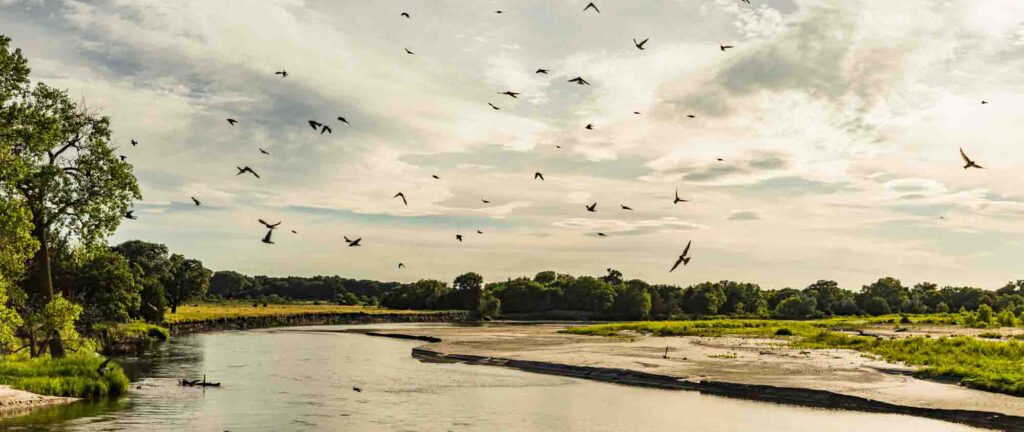
NWNL What would it take for them to start taking water from here?
JEANNE CRUMLY They just have to buy more politicians. They’re good at that.
NWNL So they would have the easement to have water pipes.
JEANNE CRUMLY Well, they have pumping stations, and they bought parcels of ground to put those pumping stations in, so they have access to the water, and the amount of water that they would draw even to begin with to start it is a phenomenal amount of water. When we have moratoriums on wells as farmers, when we have well monitoring, which is controlled, why the hell would they have that kind of access?
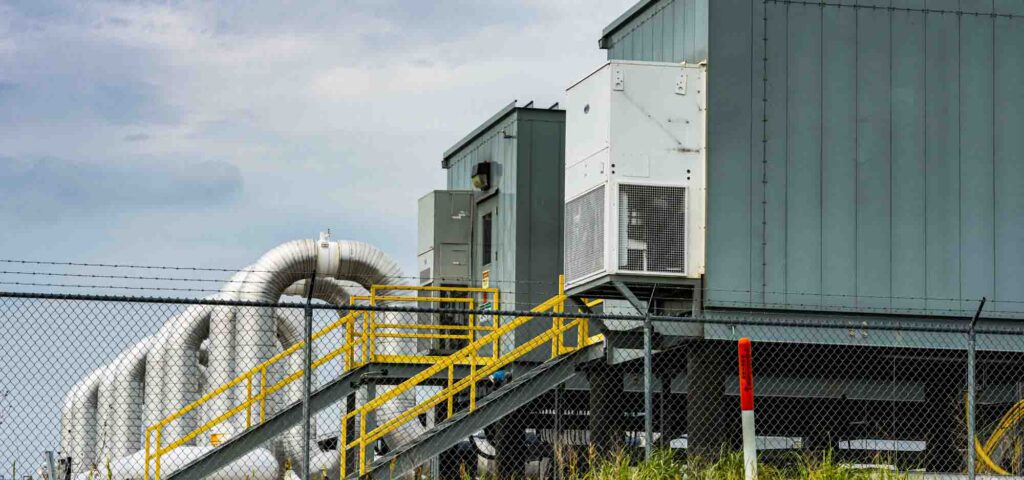
You cannot trust anything you hear or see,because backroom deals have been done. There’s something more…. They wouldn’t fight this long and hard with such an expensive fight if there weren’t more to it – but perhaps that’s just a conspiracy theory.
NWNL You said it hasn’t been proved, but it does make sense. I keep asking why TransCanada won’t spend the money to run the Canadian stretch of pipe a bit further to Keystone 1, and thus take advantage of easements already paid for and completed construction.
JEANNE CRUMLY It’s either eventually wanting water; or it’s the oil industry saying we can’t tell them what’s allowed or not. I don’t know where the power is coming from, but it’s not logical. I feel they want to say, “We’ll do whatever we want to do. We have all the politicians in our pocket, so this is what we’ll do.”
SHARYN TROESTER That’s my point of view. Think of the logic of placing KXL in one area vs. another area. And why are they waiting so long? This has been ongoing for years and years. I don’t understand it. There has to be something major, either arrogance of TransCanada’s money or that possible theory of their taking our great water resource.
NWNL Do they already have allowance for pumping stations they will need for the pipeline?
JEANNE CRUMLY They’ve already purchased parcels of land for their pumping stations.
SHARYN TROESTER I think the pumping stations are what helps the tar sands oil flow through. I think they inject water to keep it liquid.
JEANNE CRUMLY I think they’re just beginning their stress tests and things, and they’re not yet sending product through those stations. They’re probably using a big volume of water, that isn’t recharged..
SHARYN TROESTER We were meant to have a pumping station on one of our quarters. I never understood what they would do with the water, or why they needed it.
NWNL Do they have a pumping station on your land?
SHARYN TROESTER They haven’t built it. Since we’re fighting this, they cannot come on our land to do anything.
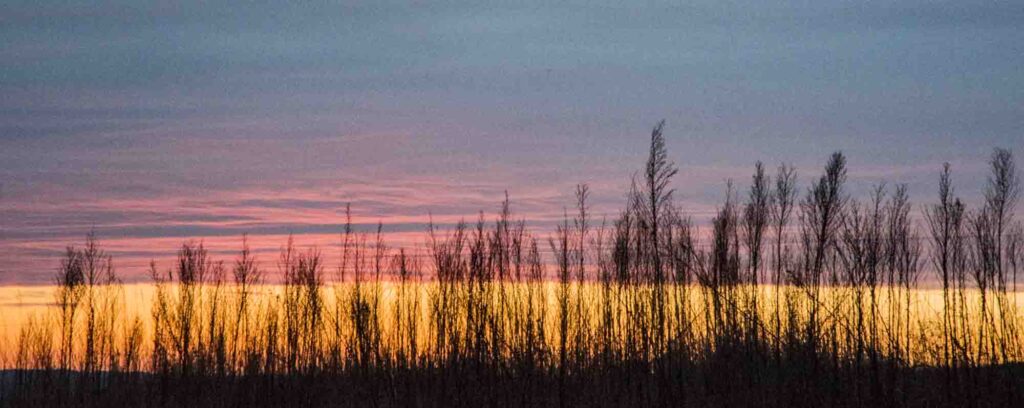
NWNL You’re on the eastern edge of the Ogallala Aquifer. The current KXL route would not be quite as deep as their first proposed route. They say this route it’s not so bad because, since it’s only on the edge of your Sandhills Prairie, a leak wouldn’t be damaging as it would have in the heart of the Sandhills where they first looked.
JEANNE CRUMLY Mostly they abandoned that route due to the fragility of the soil.
NWNL How far would a KXL leak go?
JEANNE CRUMLY Nobody would know the extent of such a leak, especially because diluted bitumen is untraceable. You can’t see, smell or taste it.
–If it’s in the Aquifer, how much would we dig it up to see if it’s clean?
–Where would we even start? How would we know if it had a leak? It’s not surface water! —- –How would we repair it?
They pacify the public by saying any underground leak would be –localized, but….
–What does “localize” mean —maybe a mile or two?
–Does that mean my farm’s whole operation? Is that localized? Or is it Sharyn’s plus mine? ——How do they know? None of that is established or proven.
–How can they say it’s safe? Scientists say there’s no known way to clean the aquifer.
SHARYN TROESTER They don’t have to deal with it. It’s not in their back yard.
JEANNE CRUMLY They’re just going to sell it.
SHARYN TROESTER TransCanada is building here because they can’t do it in Canada. We have less laws to fight them with or to use in our arguments.
–They can wait us out because they have the money.
–They think Nebraskans won’t argue the fact or do anything more.
–They say leaks on the edge won’t contaminate the whole Aquifer, but we don’t know. It’s not scientifically proven yet.
–They are okay if happens here since it’s not their backyard. One example is the wind towers proposed in Massachusetts where Ted Kennedy lived. He voted, “No, not in my sightline. I don’t want anything to obstruct my view.” Well, that proves that if you have the power and the money, you can argue your fact, and you can put it on someone else’s land.
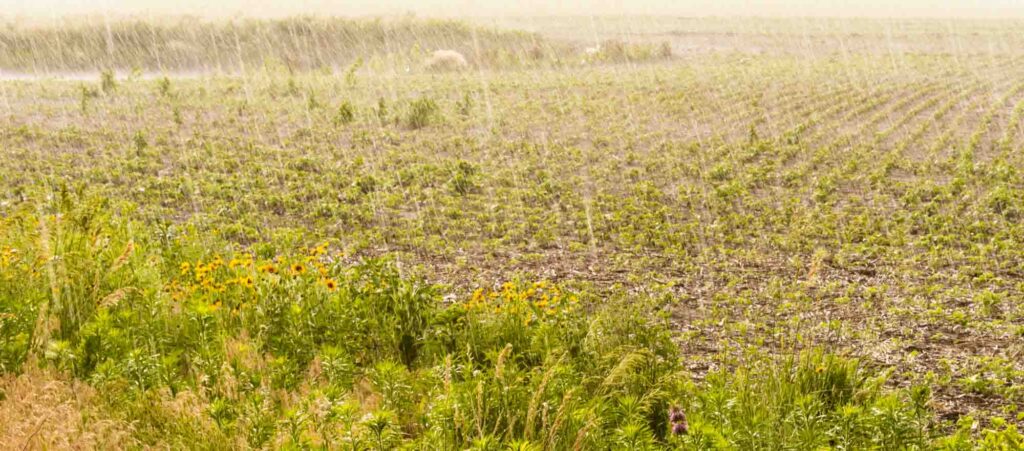
JEANNE CRUMLY Our US senator, Deb Fischer, favors the pipeline, just not on her land.
NWNL Why does she favor it? Can you put on a different hat and speak for her?
JEANNE CRUMLY She cow-tows to the Republican Party. She never votes against the party.
NWNL Has this pipeline become a party issue?
JEANNE CRUMLY Absolutely. When the House and Senate flipped during the Obama Administration and Democrats became the majority party. Their very first agenda item was the original Keystone I Pipeline. Since there was no need for that oil and no national emergency, it was a show of force, and thus became a party issue for the Republican party.
NWNL What effects, benefits, lessons learned, or efforts might you have absorbed from Standing Rock’s Dakota Access Pipeline protests, aka DAPL? Are the consequences of those protests helpful to you, or not?
SHARYN TROESTER I’m just staying steadfast in that I do not want a pipeline that potentially can leak. Plus, I am against eminent domain which should be for public use, for a public company – not for a private company, for private property. I would argue this no matter who or wherever. If you believe in a principle, continue, continue, continue.
NWNL Did DAPL protests suggest any actions you could do here that might work, actions that wouldn’t work, or yet-untried actions?
SHARYN TROESTER I just hope that the State can be vigilant enough in the future.
NWNL Jennifer what lessons do you take from DAPL that could help your community today?
JENNIFER TROESTER One of my primary jobs as a teacher is to educate our youth and get them involved in what can affect their environment . We need to create thinkers and students who analyze and become critical thinkers, because there are many lies out there.
I think Dakota Access pipeline protests are a good example of standing up for what you believe in. We can model that, even though they may have lost that fight. We must continue to stand up for what we believe in – what’s right and wrong.
NWNL I’ve heard contrasting opinions on Dakota Access pipeline protests and people resisting pipelines. Some said it was a help, some said no. Are there lessons to be learned or an energy to pick up from DAPL?
JEANNE CRUMLY Increasingly, we get information on law enforcement being corrupt, and I think we’ve already seen a shadow of that, regarding the lengths to which TransCanada is willing to go to. In essence, it’s been a friendly fight so far – but there’s an energy underneath in that there’s a legal process. We’re going to fight KXL legally for a long way, as far as we can. I think there’s potential for a landmark ruling on eminent domain that would be a service to our whole country.
There is another level – an environmental war between perspectives you can trace back further than DAPL. You can trace it to the “Nuclear Dump Fight” here in Nebraska.
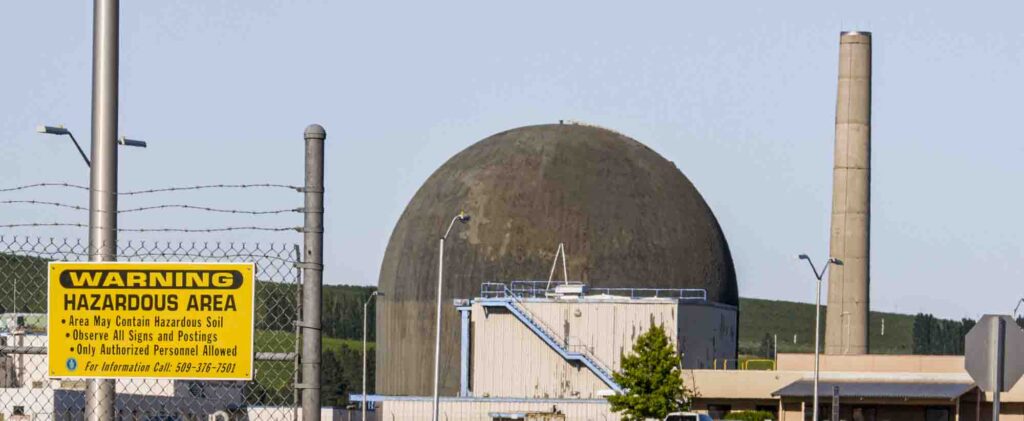
JEANNE CRUMLY There was a plan 30 years ago for a nuclear-waste dump in Boyd County.
SHARYN TROESTER The focus was on low-level waste and a need to find a dumpsite for low-level and medical waste. Nebraska and 5 other states formed a Compact. We are in the most northern part of the Compact. As I looked on the map, I thought about the impression of outsiders that this is “flyover country” – or Midwest wastelands. Not many people know about “the good life” we represent.
The Central Interstate Low-Level Radioactive Waste Compact (formed in 1983) included Nebraska and Louisiana, Oklahoma, Arkansas, Kansas. It went up to South Dakota (which wasn’t included). There were many large cities in our Compact seeking the most desolate place. We’re in the center of the United States; but for that search, we were northernmost, and the most desolate place is just north of us. The dump would be up in Boyd County.
It was jammed down the Boyd County throats. Some families were for it, some against it. But if medical or nuclear waste was leaking, “first responders” response time would be a problem because it’s so rural. During that time, the governors were Bob Kerry, then Kay Orr (the first woman governor of Nebraska) and then Ben Nelson. The governors opted to not sign the Contract to accept the low-level site. We argued and went to the legislature.
I went to Lincoln often saying, “If it’s so safe, then put it near Omaha or Lincoln.” Response was, “Oh, we can’t do that, because…,” citing this argument and that argument. I said, “But if it’s so safe, there’s no problem. And, if there’s a leak, you have the main hospitals and first responders that could be available quickly. Our responders and fire departments are volunteer. So we held that off, and we don’t have a Compact anymore regarding a nuclear low-level waste site.
JEANNE CRUMLY Yes, there are a lot of parallels between then and now. There was fierce resistance, and intense local-level organization, pre-social media! The industry miscalculated on the industry that really counts. My dad would say, “Well, these old ranchers are tougher than whang leather.”
NWNL What’s whang leather?
JEANNE CRUMLY You’ll have to look it up. It’s just a saying, but it’s a great one.
I worked in Tennessee with a fellow that designed the nuclear waste dump, and asked “Where’s Boyd County? What is it?” He said, “Oh, it’s a bunch of nothing farm ground” I said, “Hold on. Don’t ever say that to Nebraska farmers. That same miscalculation by industry enters into our KXL argument.
Jane Kleeb says, “Don’t ever underestimate the power of a Nebraska rancher. They’re tough cookies – quiet, respectful, but tougher than whang leather.” At a local level, there’s a respectful diligence, but we dig in our heels. We’ve got those three-foot roots.
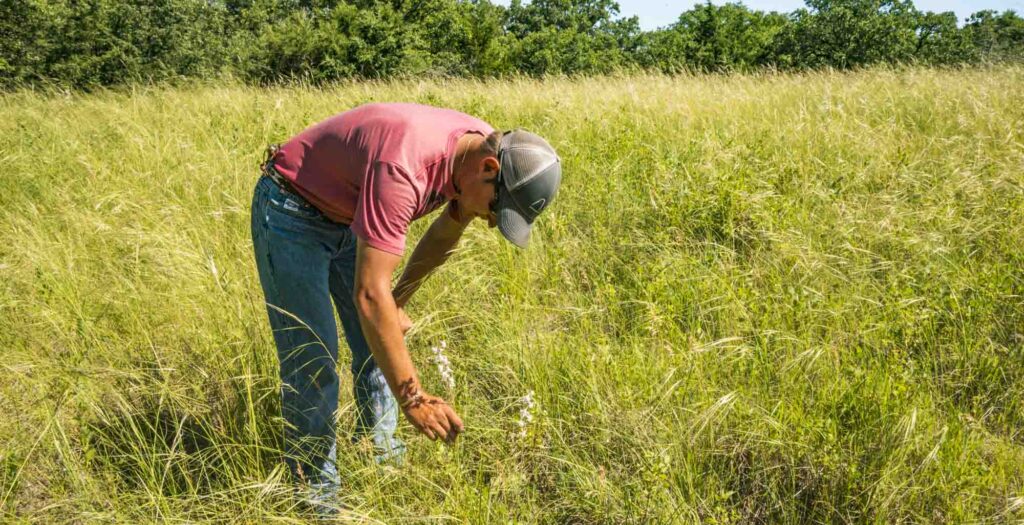
The flipside of that is probably what we saw with DAPL: a national level of environmental resistance. When I spoke in Grand Island, that came home to me for the first time as Ron and I went to the hotel breakfast room. It was filled with young kids from Oregon. They came to testify with us. This is a watershed moment in environmental policy. I think Dakota Access was a preliminary protest, and this will have the same visibility.
There was also a young mom in that breakfast room with an 11×14 portrait of her children. She said, “We own a house in Mayflower, Arkansas. It’s too late for us; but we will testify anywhere against perpetuation of this industry.” There are great young people with integrity, investment and gumption to fight on a principle. We’ve got “skin in the game.” No wonder we are passionate – there’s an entire nation that says, “This is the moment, and we have a responsibility.”
NWNL Reactions to DAPL are interesting. One leader said, “Okay, we saw what happened with DAPL protestors at Standing Rock. We’re backing off; we can’t go through that. They showed that they’re bullies, and so we’ll give up.” Yet, others say, “We learned how to do it right at DAPL. We learned we needed to get in at the very beginning before they dig any topsoil.” Some say, “Okay, Come and see what we’re doing. We learned much and we’ll do it differently; but we’ll tap into that energy. I sort of get whiplash from the many different opinions out here.
JEANNE CRUMLY I’m not in that protest world. I’m entrenched in the legal argument. I still have faith that legal argument should be the final decision-making process. I taught American Literature for a long time. There are principles embedded in the Declaration of Independence that are embedded in our national identity. They are idealistic principles, but sometimes they prevail. My money’s on Dave Domina. I’ve seen him in action. He is a work of art, grounded in principle. That’s where I put my money.
SHARYN TROESTER I put my money in principle. I like American history, so I related to the Americans that fought the big bad wolf or the big bad king in England, not that we’re going the revolutionary route, but the principle fighting for our beliefs, and that being roughshod over.
JENNIFER TROESTER I believe in people standing up for their values, for Jean and others who’ve taken on this cause, believe in it and are leaders. I believe in leaders such as Jane Kleeb and Dave Domina. They have power and money, but care enough to help Nebraskans. They care about our land as much as we do.
SHARYN TROESTER And the future.
NWNL To conclude this great discussion, what’s the best way to mobilize more support?
JEANNE CRUMLY Truth, truth, truth. Deconstruct those TransCanada arguments. They’ve been the same for 7 years, and they weren’t true then. Their KXL pipeline doesn’t give us energy independence, jobs or sustainable taxes! Those are their only arguments, and they’re all lies. Deconstruct them –and you’re left with air.
SHARYN TROESTER The fact is their presence is temporary. We’re here for the longevity.
JENNIFER TROESTER I remember a conversation with Julia, my 17-year-old, when she was in 8th grade. She asked what would happen to Kenny and the people we’ve hired on the farm:
They just think about temporary jobs that pop up, like constructing the ethanol plant. That wasn’t good for our community, but for the short term it was good for some people. But then, what about the long term… my brother Barrett who wants to stay; Jake who wants to farm; and the hired men doing jobs farms provide people for a lifetime on this land?
It eats me up when industries say, “Oh, it’ll provide all these jobs. But their projects – lining their wallets – could devastate other people’s lives and prevent different jobs.
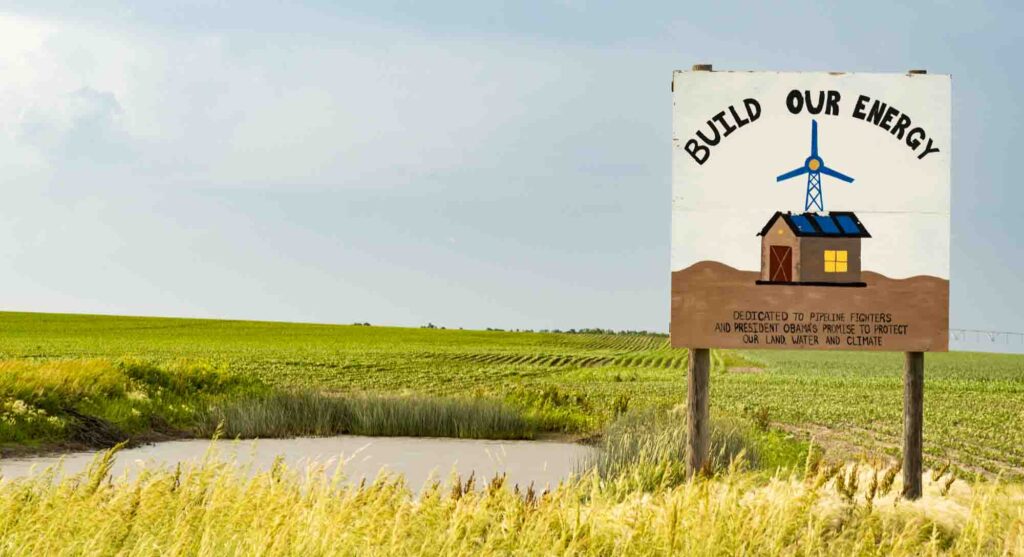
JEANNE CRUMLY As I said in my testimony:
When I look out my front door, I can look to the right and see a school quarter and creation of township and range. Establishment of school quarters was visionary and created public education in every corner of the United States. My house itself used to host George Norris, father of Tennessee Valley Authority’s rural electrification project. He envisioned what the world could be.
If I look off to the north, I see the wind towers – the energy of the 21st century. Then I see this threatening pipeline route. I conclude that even in O’Neill we can be smart and strong.
In 1952, Werner Von Braun came to O’Neill. He knew the reason German rockets failed in bombing England was they’d never mastered wind. They didn’t understand wind, but they needed to before progressing with their rocketry. So, he came to O’Neill for 6 weeks since it had wind. That was the beginning of the American Space Program. Visionaries have walked in this space. We too should look at what this space offers: a 20th-century solution to a 21st-century problem.
SHARYN TROESTER You are so good with words.
NWNL The history tied into your community is exciting and lends promise to your efforts.
SHARYN TROESTER I’m sure every part of the country has wonderful history. But right now, we’re trying to preserve ours and look into the future.
NWNL I can’t thank you three amazing women enough for the time and thoughtfulness in this morning’s discussion. I am much wiser and more encouraged than when I arrived at your door. Plus, the coffee was great! Best of luck!
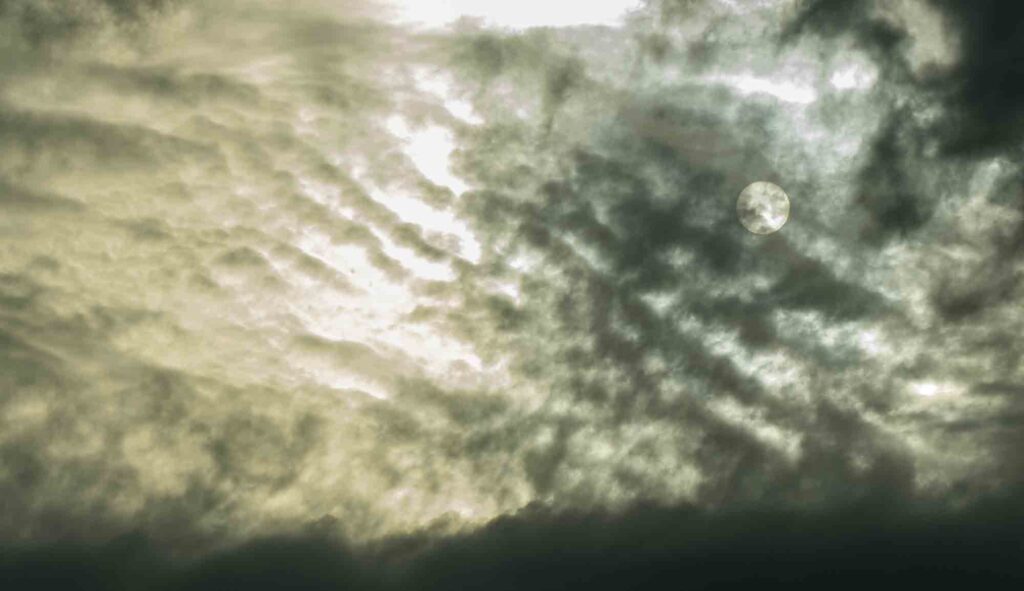
Posted by NWNL on February 11, 2024.
Transcription edited and condensed for clarity by Alison M. Jones.
All images © Alison M. Jones, unless otherwise noted. All rights reserved.
